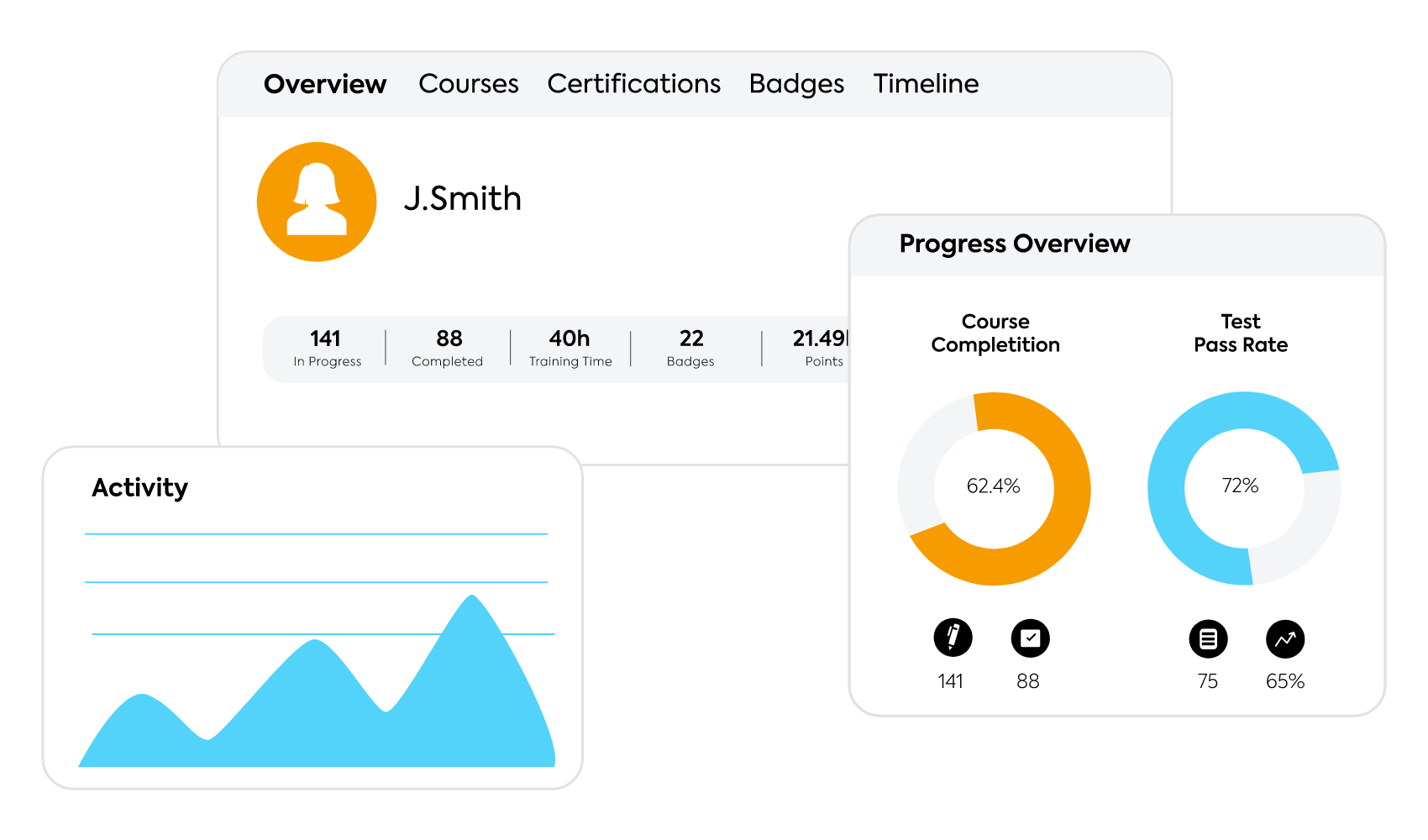After weeks of prep and implementation, your training strategy is off and running and seems to be a success. But you’re not done yet. Odds are, you’re going to come face-to-face with the need to prove your training effectiveness.
It may be that your boss wants to see the results of the training program. Or, down the road, you want to build a case for offering additional training or renewing the subscription to your training platform. Or, maybe you want to motivate employees and managers to participate more in training.
Whatever the case, you’ll need the data to back up your training decisions.
Gathering training data is essential. And can be challenging, too. In this article, we’ll talk about why you need to track training data and what challenges you’ll face. We’ll also provide solutions for overcoming those challenges and key steps for evaluating training effectiveness.
Why you need to track training data
Corporate training is more than just a box to check. You use it to update employee knowledge or skills, ensure industry and legal compliance, or improve business results. So, you put in a considerable amount of time to research the best training options for your employees.
But delivering training doesn’t automatically translate into results. If you’re training with a purpose, you need to establish goals for the program. Setting clear KPIs and tracking and reporting on them lets you know what’s working and what needs improvement.
The data also shows decision-makers and employees the value of your training strategy. And when people see the value, they’ll get on board and you’ll start seeing results.
5 common challenges in measuring training effectiveness
Measuring training effectiveness can be a daunting task at first glance. There are some hurdles that arise no matter your training strategy. But there are also solutions to each obstacle.
Consider the following five common challenges and the approaches that can help you overcome them.
Challenge #1: Failing to connect training with business outcomes
No matter how well-produced a training program is, you can’t measure the effectiveness if you don’t know what you want it to achieve. Too often, companies implement training with the notion that it will improve outcomes, but fail to specify what outcomes they want.
The solution: Begin with your goals in mind.
Set clear, SMART goals as you plan out your training strategy. Be specific about the results you want to see. Ask things like:
- What metrics do we want to change?
- In what way?
- And by when?
For example, instead of justifying a customer communication training by saying, “We want to see better customer relations,” get specific. State, “We want every customer service rep to complete the training by the end of the first quarter. Then we want to see a 20% increase in customer satisfaction scores by the end of the year.”
Those outcomes will be much easier to measure.
Deliver and track your training with TalentLMS
The training platform that users consistently rank #1.
Easy to set up, easy to use, easy to customize.
Challenge #2: Not tracking the right metrics
You may be actively gathering data around your training. But if you’re not looking at the right metrics, all that data won’t tell you whether or not the training’s working. So how do you determine what you should be tracking?
The solution: Know which metrics to prioritize.
Tie your metrics back to the goals you set. What measurements will tell you if you’re hitting those goals?
For example, if you’re delivering compliance training, your main goal is probably to have everyone go through the course and understand the material. So, it makes sense to track completion rates and quiz scores.
If people aren’t completing the course, take a look at the data around where they’re stalling. Or, note which sections they return to again and again. Then you’ll know where to make improvements or expand the content to keep learners engaged.
If your goal is to improve a business result (for example, increase the number of monthly customer conversions), just knowing that people are completing their training won’t be enough. Track the conversion numbers at regular intervals after the training to see whether it’s working.
The key is to understand the purpose of your training and prioritize the metrics that provide meaningful information.
Challenge #3: Not having the time or headcount to gather and analyze data
Most organizations don’t need a full-time training analyst. But adding the task to an already busy employee’s job description (or your own) can be overwhelming. The restraints of time and headcount can prevent you from taking on the job of gathering training data.
The solution: Automate reporting where you can.
It’s likely your LMS has built-in features for tracking—and even analyzing—key data. Set up those features to measure and report on your key metrics. Generate automatic reports, and then you can simply read off the results.
Learn to use the features your system offers to help simplify the task of data gathering and make it more efficient. And if you’re in the market for an LMS, look for one that will track the metrics you care about, and will even send your way regular reports. This way, you’ll make your life easier and cut down on the needed resources.

Turn training data into actionable info with TalentLMS
Get access to real-time, scheduled, and custom reports,
and optimize your training with no hassle.
Challenge #4: Struggling to gather qualitative data
Quantitative data is easier to collect—whether it’s through your LMS or manually. But numbers don’t always tell the full story. For example, if you’re hosting a live, in-person presentation, you can find out how many people participated. Chances are, though, that you want more info to determine training effectiveness.
The solution: Use post-training surveys to collect learner feedback.
You can get a lot of useful data by reaching out to learners after completing a course or attending a webinar with post-training evaluation surveys. Ask people what they thought of their training or quiz them on what they learned. Send out evaluations by email, through affordable (or free) online survey tools, or even directly from your LMS as soon as a course is complete.
You can also gather data through face-to-face interactions. Reach out to managers and ask what their teams thought of a certain training initiative and whether their performance has changed. Or, hold follow-up sessions where you directly ask evaluation questions and gather feedback from the team.
As long as you’re clear on the goals you’re aiming for and which metrics matter, you can find useful ways to gather the data.
Challenge #5: Not seeing the value of measuring training effectiveness
Sometimes, the biggest challenge to evaluating training success is failing to establish why you want to measure it in the first place. If decision-makers don’t see the reasoning, you’re not likely to get support for training analysis. And without it, you’ll have a hard time proving the value of your training.
The solution: Make the case up front.
Share the purposes of your strategy with your learning and development team, your boss, and anyone else whose buy-in you need to make the training a success. Specify the goals you’re targeting with training. Then, share how you intend to reach those goals and which metrics will tell you whether you’re on track.
Help others see tracking training data as an integral part of your training strategy. At this point, it’ll be useful to share training reports with key stakeholders. You’ll inform them of the progress and keep them involved. In turn, you’ll get their support and insights to help you achieve your goals.

Start measuring training success
These challenges are common considerations for every training plan, but it can be overwhelming to tackle them all at once. The good news is that you can grow your ability to gather the right metrics as you go.
Whether you’re in the middle of a training rollout or still researching your options, you can start tackling these challenges now, one at a time. Set clear goals for what success looks like, assess which metrics to prioritize, and build out a plan for tracking them.
Having a clear roadmap will help you engage other internal stakeholders in the process. And being prepared with the right data will ensure you offer the most effective L&D programs now and going forward.
